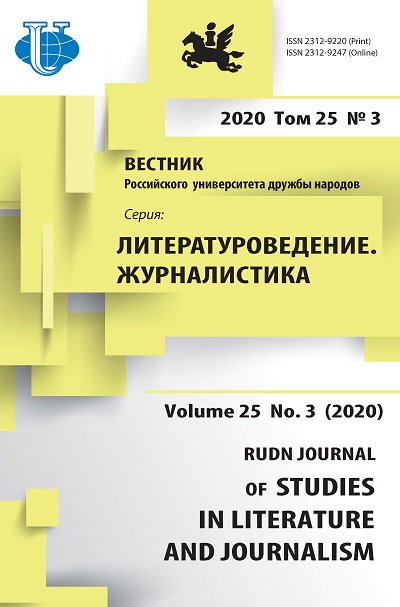Literary searches of the poets of the Far East emigration: versification poetics of Larissa Andersen
- Authors: Tsmykal O.E.1
-
Affiliations:
- Amur State University
- Issue: Vol 25, No 3 (2020)
- Pages: 447-457
- Section: LITERARY CRITICISM
- URL: https://journals.rudn.ru/literary-criticism/article/view/24821
- DOI: https://doi.org/10.22363/2312-9220-2020-25-3-447-457
- ID: 24821
Cite item
Full Text
Abstract
The article analyses the versification features of the poetess of Russian Harbin Larissa Andersen in the general context of the literary process of the Far Eastern branch of Russian emigration. The novelty of this study is determined by the fact that the versification poetics of Larissa Andersen’s works for the first time becomes the subject of independent and systematic study. The object of the study is the lyrics of L. Andersen of the Far Eastern period (1920-1940s). The purpose of the article is a holistic study of the poetics of L. Andersen versification of 1920-1940-ies on the material of her Harbin works, the collection of poems “Through the Earth’s Meadows” (1942) and the collective collection “The Island” (1946). The author of the article concludes that the technical, formal side of the verse is not a dominant for Larissa Andersen, which reflects the general immediacy of the poetess’ lyrics. However, if the concept of the work requires it, Andersen resorts to unusual means of versioning (including meter, rhyme and rhythm searches). Larissa Andersen doesn’t ignore experiments, which result in poems resembling children’s poetry, folk poetry, Chinese classical poetry, futurist lyrics, etc.
About the authors
Olga E. Tsmykal
Amur State University
Author for correspondence.
Email: sciencia@yandex.ru
master of Philology, Assistant of the Department of Literature and World Art Culture
21 Ignatievskoe Highway, Blagoveshchensk, 675000, Russian FederationReferences
- Zabijako, A.A. (2005). Tropa sud'by Alekseja Achaira [The trail of fate of Alexei Achair]. Blagoveshchensk.
- Zabijako, A.A., & Efendieva, G.V. (2008). “Chetvert' veka bezhenskoj sud'by…” (hudozhestvennyj mir liriki russkogo Harbina) [“A quarter of a century of refugee fate..” (the art world of Russian lyrics of Harbin)]. Blagoveshchensk, AmGU Publ.
- Zabijako, A.A. (2007). Lirika “harbinskoj noty”: Kul'turnoe prostranstvo, hudozhestvennye koncepty, versifikacionnaja pojetika [Lyrics of “Harbin note”: Cultural space, artistic concepts, versification poetics]. Moscow, MPGU Publ.
- Kuznetsova, O.F. (2011). “Luchshie pesni moi so mnoj…”. Iz pisem Larissy Andersen Valeriju Pereleshinu [“The best songs of mine are with me..”. From letters of Larissa Andersen to Valery Pereleshin]. Zvezda [Star], (11). Retrieved December 15, 2019, from https://zvezdaspb.ru/index.php?page=8&nput=1732
- Efendieva, G.V., & Polivan, R.V. (2010). Stihovye dominanty v lirike Larissy Andersen [Verse dominants in the lyrics of Larissa Andersen]. Russkij Harbin, zapechatlennyj v slove [Russian Harbin captured in the word], (4), 126–142.
- Andersen, L. (1940). Po zemnym lugam [Through the Earth's meadows]: Verses. Shanghai, Publishing House of Modern Woman Journal.
- Ostrov [Island]: A collection of poems. (1946). Shanghai.
- Semero [The Seven]: Collection of poems. (1931). Harbin: YMCA Publ.
- Rubezh [Frontier]. (1939). No. 20. P. 8.
- Solodkaja, M.B. (2012). L.N. Andersen. “V pogasnuvshem proshedshee voskreslo”: Pis'ma k L. Haindrovoj [L.N. Andersen. “In that what flickered out, the past has risen”: Letters to L. Khaindrova]. Kul'turnaja zhizn' Juga Rossii [Cultural life in The South of Russia], (1), 54–59.
- Rubezh [Frontier]. (1933). No. 22. P. 10.
- Gasparov, M.L. (2000). Ocherk istorii russkogo stiha [Essay on the history of Russian verse]. Moscow.
- Gasparov, M.L. (1990). Semanticheskij oreol pushkinskogo chetyrjohstopnogo horeja [The semantic halo of the Pushkin four-foot chorea]. Pushkinskie chteniya [Pushkin's readings]: Collection of articles (pp. 5–14). Tallinn.
- Lojter, S.M. (2005). Pojetika detskogo stiha v ejo otnoshenii k detskomu fol'kloru [Poetics of children's poetry in its relation to children's folklore]. Petrozavodsk, PetrGU Publ.
- Andersen, L.N. (2006). Odna na mostu: Stihotvorenija, vospominanija, pis'ma [Alone on the bridge: Poems, memories, letters]. Moscow, Russkij put' Publ.; Biblioteka-fond “Russkoe zarubezh'e” Publ.
Supplementary files















